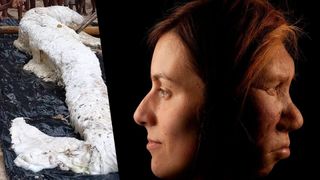
Science news this week includes a mystery mermaid “globster” and the reason some of us have more Neanderthal DNA than others.
(Image credit: New Irelanders Only/Joe McNally, Getty Images)
This week in science news we discovered a city-size comet that regrew “horns” after a volcanic eruption, gawked at gorgeous mummy portraits from 2,000 years ago and solved a mystery about why some people have more Neanderthal DNA than others.
The solar system is a violent place, as evidenced by the fiery history of 12P/Pons–Brooks, a monster-size comet hurtling toward the sun. For the second time in four months it has grown “horns” after a volcanic eruption. The flying space rock previously grew its protrusions after a magma fountain spewed from its surface in July. But destructive space rocks can’t be blamed for the biggest Marsquake ever recorded — instead, scientists finally figured out that the record-breaking shaking was caused by tectonic plates shifting beneath the Red Planet’s surface.
Archaeologists, meanwhile, unveiled some earth-shaking images of their own, from a collection of 2,000-year-old stunning mummy paintings to a jaw-dropping depiction of a long-ago New Year’s celebration that had been covered in grime for two millennia. Further back in time, archaeologists unearthed two 11,000-year-old statues, including one of a wild boar and another of a giant man clutching his nether region.
There’s still so much we don’t know about animals, including the identity of this mermaid “globster” that washed ashore in Papua New Guinea. But we do know why 10 billion snow crabs died off a few years ago: climate change caused a heat wave that starved the population. Climate change may also explain why a tropical parasite has gained a foothold in the U.S., and it also had a hand in paleontologists uncovering fossils of Jurassic-era beasts as the waters of Lake Powell in Utah receded.
And geneticists finally figured out why East Asians harbor more Neanderthal DNA than their European cousins — the latter mated with an influx of Middle-Eastern farmers thousands of years ago, diluting their Neanderthal genetic legacy.
Picture of the week
A nile crocodile (Crocodylus niloticus) was filmed with the carcass of a newborn hippo (Hippopotamus amphibius) in Kenya’s Mara River. (Image credit: Frankie Adamson/Governors’ Camp Collection)
Nature is red in tooth and claw, as evidenced by shocking footage of a crocodile about to devour a newborn hippo in the Maasai Mara nature reserve in Kenya.
The footage was captured by Frankie Adamson, a wildlife and resident photographer for the safari operator Governors’ Camp Collection, from the banks of the Mara River.
Adamson didn’t see the croc kill the newborn.
“The crocodile already had the baby hippo held in its jaws by the time I approached, and I was fairly certain it was already dead,” Adamson told Live Science. “This raised questions in my mind as to whether the crocodile had killed it, or whether it had been still-born and the carcass snatched as I later saw the baby’s umbilical cord still attached.”
After Adamson approached with her camera, the croc began thrashing around, which they sometimes do to either kill prey or break their food into smaller pieces. Crocodiles rarely approach adult hippos, but there have been sporadic reports of them snatching a baby, Adamson said.
Weekend reading
Speaking of quick meals: How long does it take to digest food?In the same vein, scientists recently created an atlas of the gut microbiomeDiving from our bowels to the bowels of the planet raises the question: What’s the deepest occurring gemstone on Earth?Have you ever wondered what animal has the most species?And just how often do orcas attack humans?
Live Science long read
Orcas (Orcinus orca) attacked an adult blue whale off the coast of Australia and inserted their heads inside the whale’s mouth to feed on its tongue. (Image credit: John Totterdell)
Speaking of orcas, in recent years, scientists have observed orcas doing some pretty terrifying things. In 2019, they documented the first time a pod of orcas hunted and ate the tongue of an adult blue whale. Earlier this summer, they were spotted ramming and sinking boats. And in South Africa, a mass-murdering duo has hunted great white sharks so relentlessly that the sharks are beginning to relocate. And in the sickest form of entertainment yet, orcas off the Pacific Northwest coast are known to toss baby porpoises in a macabre game that ends in death.
But what’s behind all these new behaviors? Just how and where did killer whales pick up these skills? And if orcas are rapidly learning and sharing these gruesome tactics with each other, does that mean they are getting smarter?
Read more: Orcas that hunted alongside humans might be extinct
Stay up to date on the latest science news by signing up for our Essentials newsletter.
Tia is the managing editor and was previously a senior writer for Live Science. Her work has appeared in Scientific American, Wired.com and other outlets. She holds a master’s degree in bioengineering from the University of Washington, a graduate certificate in science writing from UC Santa Cruz and a bachelor’s degree in mechanical engineering from the University of Texas at Austin. Tia was part of a team at the Milwaukee Journal Sentinel that published the Empty Cradles series on preterm births, which won multiple awards, including the 2012 Casey Medal for Meritorious Journalism.
>>> Read full article>>>
Copyright for syndicated content belongs to the linked Source : Live Science – https://www.livescience.com/health/science-news-this-week-horned-comet-and-a-mystery-blob
